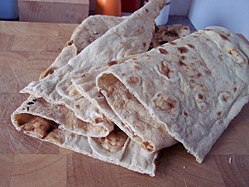 | |
| Type | Bread |
|---|---|
| Place of origin | Turkey |
| Main ingredients | Wheat flour, yeast |
Ramazan pidesi (Turkish for Ramadan pita) is a traditional soft leavened Turkish bread.
Contents
Round and rather flat in form, and having a weave-like patterned crust, Ramazan pidesi is made of wheat flour with yeast, and topped with sesame and Nigella sativa seeds. [1] [2]
It is traditionally served for the iftar and sahur meals during the holy month of Ramadan. [3]
